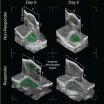(Press-News.org) WASHINGTON, Feb. 20, 2013— Digital cameras, medical scanners, and other imaging technologies have advanced considerably during the past decade. Continuing this pace of innovation, an Austrian research team has developed an entirely new way of capturing images based on a flat, flexible, transparent, and potentially disposable polymer sheet. The team describes their new device and its possible applications in a paper published today in the Optical Society's (OSA) open-access journal Optics Express.
The new imager, which resembles a flexible plastic film, uses fluorescent particles to capture incoming light and channel a portion of it to an array of sensors framing the sheet. With no electronics or internal components, the imager's elegant design makes it ideal for a new breed of imaging technologies, including user interface devices that can respond not to a touch, but merely to a simple gesture.
"To our knowledge, we are the first to present an image sensor that is fully transparent – no integrated microstructures, such as circuits – and is flexible and scalable at the same time," says Oliver Bimber of the Johannes Kepler University Linz in Austria, co-author of the Optics Express paper.
The sensor is based on a polymer film known as a luminescent concentrator (LC), which is suffused with tiny fluorescent particles that absorb a very specific wavelength (blue light for example) and then reemit it at a longer wavelength (green light for example). Some of the reemitted fluorescent light is scattered out of the imager, but a portion of it travels throughout the interior of the film to the outer edges, where arrays of optical sensors (similar to 1-D pinhole cameras) capture the light. A computer then combines the signals to create a gray-scale image. "With fluorescence, a portion of the light that is reemitted actually stays inside the film," says Bimber. "This is the basic principle of our sensor."
For the luminescent concentrator to work as an imager, Bimber and his colleagues had to determine precisely where light was falling across the entire surface of the film. This was the major technical challenge because the polymer sheet cannot be divided into individual pixels like the CCD camera inside a smartphone. Instead, fluorescent light from all points across its surface travels to all the edge sensors. Calculating where each bit of light entered the imager would be like determining where along a subway line a passenger got on after the train reached its final destination and all the passengers exited at once.
The solution came from the phenomenon of light attenuation, or dimming, as it travels through the polymer. The longer it travels, the dimmer it becomes. So by measuring the relative brightness of light reaching the sensor array, it was possible to calculate where the light entered the film. This same principle has already been employed in an input device that tracks the location of a single laser point on a screen.
The researchers were able to scale up this basic principle by measuring how much light arrives from every direction at each position on the image sensor at the film's edge. They could then reconstruct the image by using a technique similar to X-ray computed tomography, more commonly known as a CT scan.
"In CT technology, it's impossible to reconstruct an image from a single measurement of X-ray attenuation along one scanning direction alone," says Bimber. "With a multiple of these measurements taken at different positions and directions, however, this becomes possible. Our system works in the same way, but where CT uses X-rays, our technique uses visible light."
Currently, the resolution from this image sensor is low (32x32 pixels with the first prototypes). The main reason for this is the limited signal-to-noise ratio of the low-cost photodiodes being used. The researchers are planning better prototypes that cool the photodiodes to achieve a higher signal-to-noise ratio.
By applying advanced sampling techniques, the researchers can already enhance the resolution by reconstructing multiple images at different positions on the film. These positions differ by less than a single pixel (as determined by the final image, not the polymer itself). By having multiple of these slightly different images reconstructed, it's possible to create a higher resolution image. "This does not require better photodiodes," notes Bimber, "and does not make the sensor significantly slower. The more images we combine, the higher the final resolution is, up to a certain limit."
The main application the researchers envision for this new technology is in touch-free, transparent user interfaces that could seamlessly overlay a television or other display technology. This would give computer operators or video-game players full gesture control without the need for cameras or other external motion-tracking devices. The polymer sheet could also be wrapped around objects to provide them with sensor capabilities. Since the material is transparent, it's also possible to use multiple layers that each fluoresce at different wavelengths to capture color images.
The researchers also are considering attaching their new sensor in front of a regular, high-resolution CCD sensor. This would allow recording of two images at the same time at two different exposures. "Combining both would give us a high-resolution image with less overexposed or underexposed regions if scenes with a high dynamic range or contrast are captured," Bimber speculates. He also notes that the polymer sheet portion of the device is relatively inexpensive and therefore disposable. "I think there are many applications for this sensor that we are not yet aware of," he concludes.
INFORMATION:
Paper: "Towards a transparent, flexible, scalable and disposable image sensor using thin-film luminescent concentrators," A. Koppelhuber and O. Bimber, Optics Express, Vol. 21, Issue 4, pp. 4796-4810 (2013) (link: http://www.opticsinfobase.org/oe/abstract.cfm?uri=oe-21-4-4796).
EDITOR'S NOTE: Images are available to members of the media upon request. Contact Angela Stark, astark@osa.org.
About Optics Express
Optics Express reports on new developments in all fields of optical science and technology every two weeks. The journal provides rapid publication of original, peer-reviewed papers. It is published by the Optical Society and edited by Andrew M. Weiner of Purdue University. Optics Express is an open-access journal and is available at no cost to readers online at www.OpticsInfoBase.org/OE.
About OSA
Uniting more than 180,000 professionals from 175 countries, the Optical Society (OSA) brings together the global optics community through its programs and initiatives. Since 1916 OSA has worked to advance the common interests of the field, providing educational resources to the scientists, engineers and business leaders who work in the field by promoting the science of light and the advanced technologies made possible by optics and photonics. OSA publications, events, technical groups and programs foster optics knowledge and scientific collaboration among all those with an interest in optics and photonics. For more information, visit www.osa.org.
New imaging device that is flexible, flat, and transparent
Fluorescent light traveling through polymer sheet may lead to user interface devices that respond to gestures alone
2013-02-20
ELSE PRESS RELEASES FROM THIS DATE:
Can insurers save money by providing free diabetes-related medications and supplies?
2013-02-20
New Rochelle, NY, February 20, 2013–Reducing financial barriers to medication access—a strategy known as value-based insurance design (VBID)—can improve medication adherence and management of chronic diseases such as diabetes. The economic and patient-perceived benefits of eliminating co-payments for diabetes-related medications and supplies are described in a trend-setting study published in Population Health Management, a peer-reviewed journal from Mary Ann Liebert, Inc., publishers. The article is available free on the Population Health Management website at http://www.liebertpub.com/pop.
In ...
Ancient 'Egyptian blue' pigment points to new telecommunications, security ink technology
2013-02-20
A bright blue pigment used 5,000 years ago is giving modern scientists clues toward the development of new nanomaterials with potential uses in state-of-the-art medical imaging devices, remote controls for televisions, security inks and other technology. That's the conclusion of an article on the pigment, Egyptian blue, in the Journal of the American Chemical Society.
Tina T. Salguero and colleagues point out that Egyptian blue, regarded as humanity's first artificial pigment, was used in paintings on tombs, statues and other objects throughout the ancient Mediterranean ...
6 in 10 people worldwide lack access to flush toilets or other adequate sanitation
2013-02-20
It may be the 21st century, with all its technological marvels, but 6 out of every 10 people on Earth still do not have access to flush toilets or other adequate sanitation that protects the user and the surrounding community from harmful health effects, a new study has found. The research, published in ACS' journal Environmental Science & Technology, says the number of people without access to improved sanitation is almost double the previous estimate.
amie Bartram and colleagues explain that the current definition of "improved sanitation" focuses on separating humans ...
Trustworthy mating advice deepens bond between straight women and gay men
2013-02-20
Why do straight women and gay men form close relationships with one another? A new psychology study from The University of Texas at Austin suggests the glue that cements these unique relationships is honest, unbiased relationship advice.
The study, published online in the February issue of Evolutionary Psychology, is the first to provide empirical evidence that the emotional closeness shared by straight women and gay men is rooted in the absence of deceptive mating motivations.
"Friendships between straight women and gay men are free of hidden mating agendas," says ...
Preclinical study shows potential of new technologies to detect response to cancer therapy earlier
2013-02-20
The research was published early in the January issue of the journal Technology in Cancer Research and Treatment. The article describes experiments using ultrasonic molecular imaging (USMI) and Dynamic Contrast Enhanced-Perfusion Imaging (DCE-PI) to measure response to therapy for pancreatic cancer.
Paul Dayton, PhD, senior author says, "What we found is that using two non-invasive technologies, we can detect response to therapy earlier than by relying on tumor volume changes. Having new non-invasive, inexpensive technologies available to measure response to therapy earlier ...
Pitt study examines cost-effectiveness of medicare drug plans in schizophrenia and bipolar disorder
2013-02-20
PITTSBURGH, Feb. 19, 2013 – A new study published online today in the American Journal of Managed Care found that in Medicare Part D, generic drug coverage was cost-saving compared to no coverage in bipolar disorder and schizophrenia, while also improving health outcomes. Researchers from the University of Pittsburgh School of Medicine, the Pitt Graduate School of Public Health, and Western Psychiatric Institute and Clinic of UPMC note that policymakers and insurers should consider generic-only coverage, rather than no gap coverage, to both conserve health care resources ...
Using millions of gigs of data to improve human health
2013-02-20
With biomedical scientists struggling to collect and analyze millions of gigabytes of data in their efforts to improve human health, the National Institutes of Health has launched a $700 million project to develop a common data-sharing framework and start training future scientists to tap that gold mine of information. That's the topic of a story in the current edition of Chemical & Engineering News (C&EN), the weekly newsmagazine of the American Chemical Society, the world's largest scientific society.
Britt E. Erickson, C&EN senior editor, explains that biomedical researchers ...
Little did we know about beetle diversity: Astonishing 138 new species in a single genus
2013-02-20
The tropics are home to an extraordinary diversity of insect species. How great is it, exactly? We do not know, but today, researchers at the Santa Barbara Museum of Natural History published a study on tropical beetles that can help us progress towards an answer to this question. The paper was published in the open access, peer-reviewed journal Zookeys.
Entomologists Michael Caterino and Alexey Tishechkin have named 138 new species within the genus Operclipygus (the name refers to their clamshell-like rear end), thereby increasing the size of the genus over six times. ...
Potential benefits of inertial fusion energy justify continued R&D
2013-02-20
WASHINGTON -- The potential benefits of successful development of an inertial confinement fusion-based energy technology justify investment in fusion energy research and development as part of the long-term U.S. energy R&D portfolio, says a new report from the National Research Council. Although ignition of the fusion fuel has not yet been achieved, scientific and technological progress in inertial confinement fusion over the past decade has been substantial. Developing inertial fusion energy would require establishment of a national, coordinated, broad-based program, ...
Molecules assemble in water, hint at origins of life
2013-02-20
The base pairs that hold together two pieces of RNA, the older cousin of DNA, are some of the most important molecular interactions in living cells. Many scientists believe that these base pairs were part of life from the very beginning and that RNA was one of the first polymers of life. But there is a problem. The RNA bases don't form base pairs in water unless they are connected to a polymer backbone, a trait that has baffled origin-of-life scientists for decades. If the bases don't pair before they are part of polymers, how would the bases have been selected out from ...
LAST 30 PRESS RELEASES:
Low daily alcohol intake linked to 50% heightened mouth cancer risk in India
American Meteorological Society announces Rick Spinrad as 2026 President-Elect
Biomass-based carbon capture spotlighted in newly released global climate webinar recording
Illuminating invisible nano pollutants: advanced bioimaging tracks the full journey of emerging nanoscale contaminants in living systems
How does age affect recovery from spinal cord injury?
Novel AI tool offers prognosis for patients with head and neck cancer
Fathers’ microplastic exposure tied to their children’s metabolic problems
Research validates laboratory model for studying high-grade serous ovarian cancer
SIR 2026 delivers transformative breakthroughs in minimally invasive medicine to improve patient care
Stem Cell Reports most downloaded papers of 2025 highlight the breadth and impact of stem cell research
Oxford-led study estimates NHS spends around 3% of its primary and secondary care budget on the health impacts of heat and cold in England
A researcher’s long quest leads to a smart composite breakthrough
Urban wild bees act as “microbial sensors” of city health.
New study finds where you live affects recovery after a hip fracture
Forecasting the impact of fully automated vehicle adoption on US road traffic injuries
Alcohol-related hospitalizations from 2016 to 2022
Semaglutide and hospitalizations in patients with obesity and established cardiovascular disease
Researchers ‘listen in’ to embryo-mother interactions during implantation using a culture system replicating the womb lining
How changing your diet could help save the world
How to make AI truly scalable and reliable for real-time traffic assignment?
Beyond fragmented markets: A new framework for efficient and stable ride-pooling
Can shape priors make road perception more reliable for autonomous driving?
AI tracks nearly 100 years of aging research, revealing key trends and gaps
Innovative techniques enable Italy’s first imaging of individual trapped atoms
KIER successfully develops Korea-made “calibration thermoelectric module” for measuring thermoelectric device performance
Diversifying US Midwest farming for stability and resilience
Emphasizing immigrants’ deservingness shifts attitudes
Japanese eels, climate change, and river temperature
Pusan National University researchers discover faster, smarter heat treatment for lightweight magnesium metals
China’s 2024 Gastroenterology Report: marked progress in endoscopy quality and disease management
[Press-News.org] New imaging device that is flexible, flat, and transparentFluorescent light traveling through polymer sheet may lead to user interface devices that respond to gestures alone




